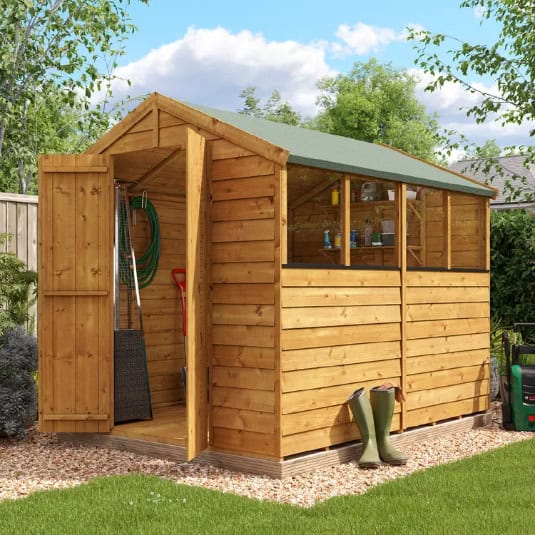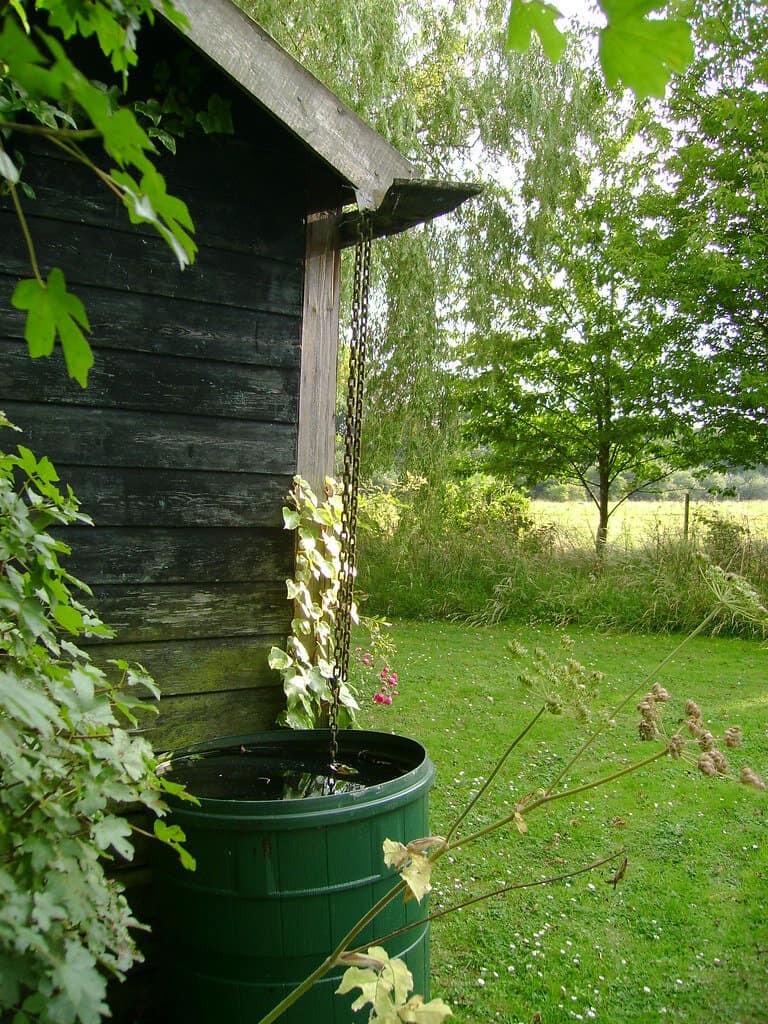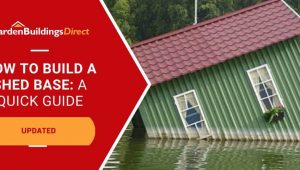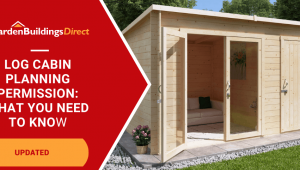Jump to:
When you’ve installed a new shed, the surrounding area can end up looking like a bare mess thanks to all that preparation you did to clear the area. You might have a sad-looking patch of grass, or nothing at all. But with a bit of thought, you can make the space around it work, whether with paths, borders, or plants. Here are ten landscape ideas around a shed to get started.
Landscape Ideas Around a Shed
If the area around your wooden shed hasn’t had much attention lately, here’s what you can do about it:
Gravel or paving perimeter

Always leave a clear gap between your shed and any soil or grass to keep moisture from creeping in. For this idea, you’ll need to work with gravel, paving slabs, or a compacted base. These free-draining materials direct water away, stopping it from pooling near the walls.
Keep this strip at least a foot wide, if possible. Don’t plant directly against the shed, even small shrubs. They trap moisture and stop airflow, which wooden sheds don’t handle well.
If you want plants nearby, use raised planters or leave a bit of space between them and the shed. It’s easier all around; you won’t be fighting through leaves every time you need to check the wall or clean it.
A pathway leading to the shed

Stepping stones, bark, or paving slabs make good options for a pathway. They can run from the house, patio, or wherever you come in and out of the garden, leading straight to the shed.
Match the path to how you use the space. Say, if you’re walking across grass every time you go to the shed, the path should follow that line.
Now, if you’re using a modular shed like the BillyOh Switch, you’ve got more flexibility. You can choose which side the door goes on, so fit it to your path and not the other way round. It’s a small detail, but it saves you from walking the long way round every time.
Go for low-maintenance plant borders

Not keen on a bare shed but don’t want the hassle of overgrown plants either? You can still add greener, just don’t plant too close.
Raised beds or planters are your best bet for achieving this layout. Place them far enough from the walls so nothing touches the timber. A gravel strip between the base and the soil or roots does the job of separating them.
As for the plants, try lavender, rosemary, dwarf box, or ornamental grasses. They don’t grow out of hand or need constant care. Want a bit of colour through the year? Drop in a few bedding plants or trailing varieties in containers.
Keep it neat and leave space to walk, so you’re not always cutting back plants to reach the shed.
Add screening for privacy

A simple screen can break up the view if your shed feels exposed or you want to hide your wheelie bins. A trellis, slatted panel, or woven fence panel—any of these will work.
We recommend open-style screens that let air move through. You can leave them bare or add a few climbing plants, like clematis or star jasmine, to fill the gaps. This will make the screen denser, giving you better privacy. Not only that, but it also shapes the space around your shed and ties it to the rest of the garden.
Tip: Always leave a gap for airflow, especially with wooden sheds. Don’t close it off completely or push anything right up against the walls.
Have a look at this guide for more: Garden Privacy Ideas
Plant taller greenery near the corners
Taller plants in the right places can change how your shed sits in the garden. Plant small trees, tall grasses, or upright shrubs a few feet out from the shed, about 2 to 3 feet.
Remember, the goal isn’t to hide the shed but to take the edge off the corners. Pick plants that grow upright, like Miscanthus, dwarf conifers, or bamboo in containers. You get the height without the bulk.
Leave space between the shed and the plants to allow air and light to pass through. You’ll also need that gap to get around the shed for checks and cleaning.
Grow herbs or vegetables next to the shed
That spare space and sun near your shed is a great spot for growing herbs or a few veggies. Even better, it doesn’t take much to set it up. Raised beds, trough planters, or even old containers will do.
Start with herbs like thyme, mint (in a pot, so it doesn’t spread), parsley, or chives. Lettuce, chillies, and spring onions are all easy wins too if you’ve got the sun. Handy for cooking, and it makes better use of that corner too.
If you use your shed for potting or storing tools, keeping your mini green space also saves time. No need to cross the garden every time you need a trowel or watering can.
Tip: Don’t push planters right up to the wall and give yourself walking space around the shed. It’ll save you hassle later when it’s time to do checks or clean-ups.
Set up a sitting corner
You don’t always need a full patio to enjoy the garden. If the side of your shed gets a bit of sun and faces outwards, it’s a good spot to claim. Put in a bench, a garden chair, or a compact bistro table. Add a small side table if there’s room for your brew, lunch, or tools while you’re out there.
Use hard ground underneath, such as gravel, decking, or a few slabs, so it’s dry and solid underfoot. You want something you can use year-round, not only when the grass is dry.
Light the shed area
A shed without outdoor lighting might be fine during the day, but it can be a hassle at night. The best way to deal with this is to light up the area. Solar path lights to line the walkway and spike lights to the nearby beds—that way, you don’t need to wire anything in.
For something brighter near the door, mount a battery or solar lantern on a nearby post. You’ll thank yourself when you’re not stumbling over steps or trying to unlock the door in the dark.
Tip: Outline the area, such as along borders, around beds, or near your sitting spot, to define that part of the garden.
Sort the runoff

Rainwater needs somewhere to go, or it’ll pool behind the shed and leave you with a boggy corner. And it would be a waste to put in the effort around the shed only to have the back turn into a muddy patch.
Fit a water butt to the downpipe at the back or side of the structure. This will catch rainwater from the roof and give you a way to collect it for later use.
Add a gravel base underneath to keep the area from turning muddy when it rains. If water still builds up in that spot, dig a shallow trench and fill it with gravel to help drain it off.
Keep your shed border clear
Don’t leave the area around the shed to chance. Line the base with bark, gravel, or lawn edging to achieve that clean finish and keep things under control. Keep the strip wide enough so you’re not brushing right up against the shed when you’re cutting back.
With this effort, it will stop weeds and grass from spreading into the walls. You also won’t have to wrestle with the mower every time you cut the lawn. Does the job, don’t you think?
Tip: Bark blends better with planting, while gravel gives a neater edge and is good with drainage. Medium-grade bark won’t shift around easily too.
Round-up
You’ve got the garden building, so now make the most of the space around it. If any of these landscape ideas around a shed fit your outdoor space, give them a go. Start with one, then see what else makes sense to add.
Get more inspiration here: Lawn Care Ideas for a Healthier Landscape





